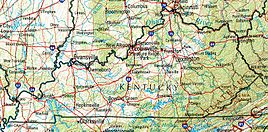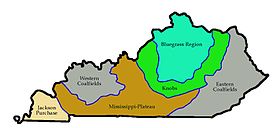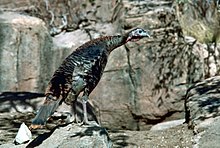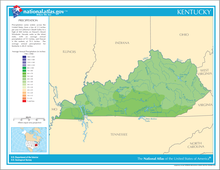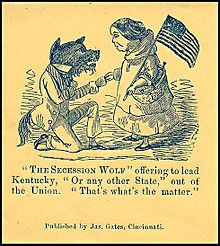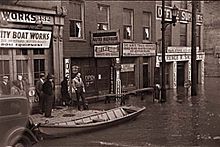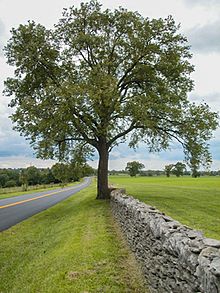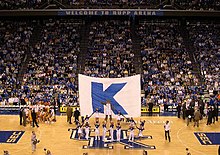Kentucky
| Kentucky | |||||
|---|---|---|---|---|---|
| |||||
| List of states | |||||
| Capital: | Frankfort | ||||
| State motto: | United We Stand, Divided We Fall | ||||
| Official language : | English | ||||
| Surface: | 104,659 km² | ||||
| Residents: | 4,436,974 (estimated 2016) (42.5 U / km²) | ||||
| Member since: | June 1, 1792 | ||||
| Time zone: | Eastern: UTC − 5 / −4 Central: UTC − 6 / −5 |
||||
| The highest point: | 1,262 m ( Black Mountain ) | ||||
| Average Height: | 230 m | ||||
| Deepest point: | 78 m Mississippi River | ||||
| Governor : | Andy Beshear ( D ) | ||||
| Post / Office / ISO | KY / / US KY | ||||
| Map of Kentucky | |||||
| Kentucky Geographical Map | |||||
Kentucky ( English pronunciation [ kənˈtʰʌki ] ) (officially The Commonwealth of Kentucky ) is a state of the United States of America . The name of the state is of Shawnese or Iroquois origin, possibly from Wyandot , meaning "meadow", "floodplain", "corridor". In Senecan , also an Iroquois language, the word geda'go means "in the field". The nickname Bluegrass State , by which the blue-green flowering grass pastures are meant from March to April , is Kentucky as a common description.
Kentucky was initially part of Virginia and became the 15th state to join the United States in 1792 . During the Civil War , Kentucky initially tried to remain neutral, then residents of the state stood on both sides, such as B. Abraham Lincoln as President of the Union and Jefferson Davis as President of the Confederation . However, the United States Census Bureau now clearly ranks Kentucky among the southern states .
In addition to the states of Virginia , Pennsylvania and Massachusetts , Kentucky bears the official name “ Commonwealth of Kentucky” in contrast to the otherwise common designation of the member states as “State”.
geography
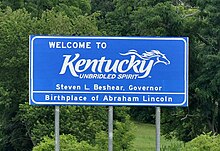
Location and demarcation
Kentucky is between 36 ° 30 'and 39 ° 9' north latitude and between 81 ° 58 'and 89 ° 34' west longitude. The national territory thus extends over 225 km north-south and 610 km east-west and comprises 104,659 km².
Kentucky borders the Midwest and Southern United States. It lies between West Virginia , Virginia, Tennessee , Missouri , Illinois , Indiana, and Ohio . In the north it is bounded by the Ohio River .
It is the only US state with an exclave that is only enclosed by other states: In western Kentucky in Fulton County , the small strip of land of Kentucky Bend on the Mississippi , which was formed by the New Madrid earthquake of 1811 , is bordered by the state Missouri and only accessible via Tennessee.
Regions
There are five main regions: the Cumberland Mountains , the Cumberland Plateau in the southeast, the "Bluegrass Region " in the north, the Pennyroyal Plateau , also called "Pennyrile" , in the south and west , the coal fields in the west and the Jackson Purchase in the extreme west.
The Eastern Coal Fields, a rugged, mountainous region that is heavily forested and cut by rivers, has the highest peaks and is located in the River Valley. The highest mountain is Black Mountain in Harlan County with 1292 m . The western portion of the region encompasses much of the Daniel Boone National Forest .
The "busy" headquarters of Kentucky, the Bluegrass Region, is located in the north of the state. Geologically, it belongs to the oldest part of the state. The lime-rich soil forms the basis for growing grain and for pasture areas.
The Mississippi Plateau is only separated from it by a series of smaller low mountain range hills , the Knobs .
The Western Coal Fields, bounded in the north and northwest by the Ohio River , already belong to the Illinois Basin.
The southwestern part of the state is a low lying plain called the Jackson Purchase. This is also the lowest point of Kentucky in Fulton County in the course of the Mississippi, around 78 m above sea level. d. M. It was named after the future President Andrew Jackson , who in 1818 had initiated the purchase of the land from the Chickasaw as an officially authorized representative. The huge alluvial land forms one of the most productive agricultural areas in the country.
rivers and lakes
Large rivers like the Ohio or the Mississippi, which also shape the neighboring states, determine the landscape and the borders of Kentucky, with the entire river network making up around 140,000 km. Other major rivers include the Red and Green Rivers , the Tennessee Rivers , the Cumberland and Rough Rivers , the Big Sandy Rivers , the Licking, and the Kentucky Rivers . Kentucky is also the only state bound by rivers on three sides: the Mississippi to the west, the Ohio to the north, and the Big Sandy River and Tug Fork to the east. Even if the state itself has only three larger natural lakes, it has a few reservoirs , some of which were created by means of dams as job creation measures during Franklin D. Roosevelt's New Deal policy , such as B. Lake Barkley on the Cumberland River, named after Vice President Alben W. Barkley , or Dewey Lake on Big Sandy. The Red River supposedly owes its name to the large amount of blood that was shed during the fierce Indian fighting in the late 18th century.
natural reserve
Kentucky has an extensive nature reserve system. This includes a national park, the Mammoth Cave National Park , two national recreation areas, two national historical parks, two national forest areas , 52 state parks , 153 km² national forest and 82 wildlife management areas .
The state is also part of two of the most successful biological release or reintroduction projects in United States history. In the winter of 1997, the Kentucky Department of Fish and Wildlife Resources began resettling elk in the eastern counties, which had been extinct in the area for over 150 years. In 2009 the project reached its goal of 10,000 animals, making it the largest population east of the Mississippi.
Kentucky had successfully released wild turkeys , which were also extinct here , back in the 1950s . Today more turkeys live here than in any other eastern state.
structure
climate
Since Kentucky is located in the southeastern inner part of North America, there is a humid, subtropical climate of temperate nature with cool winters and warm summers . The average temperatures fluctuate between 30.9 ° C in summer and −4.9 ° C in winter with 1168.4 mm of precipitation. The annual mean is around 14 ° C in a large part of the country. The temperature extremes fluctuate between -36.7 ° C in Cynthiana in 1963 and +45.6 ° C in Greensburg in the summer of 1930. In contrast, snow cover of more than 60 cm is often found in the foothills of the Appalachian Mountains in winter . Kentucky lies in the catchment area of various storm systems , which mostly occur between March and September, sometimes as a tornado . The most violent storm catastrophes occurred in 1890 with the tornado around Louisville with at least 76 and 1974 in the " Super Outbreak " with 72 fatalities. In the recent past, a flood in 1997 claimed 18 lives, the so-called Super Tuesday tornado outbreak , which also affected several other states, with 17 casualties in Kentucky alone, and a national ice storm in January 2009 in which at least 24 people were killed.
fauna and Flora


Until the arrival of European settlers, the plains and forests were home to Kentucky's wandering large mammals such as bison , the elk or moose . Today, only smaller mammals like muskrats , foxes , squirrels , rabbits , marmots , possums and raccoons , but also deer, usually live here .
There is a much wider range of bird species: from the bald eagle to the wren , almost everything is available. Typical birds are the red cardinal , the "state bird", the mockingbird , the sap eater , the kingfisher and various types of woodpecker . One of the country's most important migratory bird trails runs from the west of the state to the Ohio and Mississippi .
The Cumberland Mountains as the western foothills of the Appalachian Mountains on the border with Virginia are among the most species-rich mesophytic forests in the temperate zone of the northern hemisphere. Around 30 species are found in the tree layers that are up to 35 m high. Today forests cover around 40% of the national territory. Mostly there are deciduous trees such as maple , birch , oak , horse chestnut and walnut . But conifers such as hemlocks , pines , Virginian junipers or cypresses are also frequently represented. Typical plants in the area are rhododendrons , bay rose , blueberry , tulip tree , goldenrod and mint . The lower tree layers are also very species-rich. Such forests ( cove forests ) in humid depressions on concave slopes are characterized by tall growth and straight trunks. The core regions of the mesophytic forests are regarded as geologically important genetic reservoirs for the distribution of many forest species.
population
| Population development | |||
|---|---|---|---|
| Census | Residents | ± in% | |
| 1790 | 73,677 | - | |
| 1800 | 220.955 | 199.9% | |
| 1810 | 406.511 | 84% | |
| 1820 | 564,317 | 38.8% | |
| 1830 | 687.917 | 21.9% | |
| 1840 | 779.828 | 13.4% | |
| 1850 | 982.405 | 26% | |
| 1860 | 1,155,684 | 17.6% | |
| 1870 | 1,321,011 | 14.3% | |
| 1880 | 1,648,690 | 24.8% | |
| 1890 | 1,858,635 | 12.7% | |
| 1900 | 2,147,174 | 15.5% | |
| 1910 | 2,289,905 | 6.6% | |
| 1920 | 2,416,630 | 5.5% | |
| 1930 | 2,614,589 | 8.2% | |
| 1940 | 2,845,627 | 8.8% | |
| 1950 | 2,944,806 | 3.5% | |
| 1960 | 3,038,156 | 3.2% | |
| 1970 | 3,218,706 | 5.9% | |
| 1980 | 3,660,777 | 13.7% | |
| 1990 | 3,685,296 | 0.7% | |
| 2000 | 4,041,769 | 9.7% | |
| 2010 | 4,339,367 | 7.4% | |
| Before 1900
1900–1990 2000 + 2010 |
|||
Kentucky has 4,339,367 inhabitants (as of: Census 2010), of which 86.3% are white (excluding Hispanics and Latinos), 7.8% African-Americans, 3.1% Hispanics or Latinos, 1.1% Asians , 0.2% Indians.
Age and gender structure
The age structure of Kentucky in 2014 was composed as follows:
- up to 18 years: 1,015,095 (23.0%)
- 18–64 years: 2,745,170 (62.2%)
- from 65 years: 653,192 (14.8%)
The median age is 38.5 years. 49.2% of the population are male and 50.8% are female.
Eight of the total of 13 US counties where life expectancy was lower in 2015 than last year are in Kentucky. And the regions affected are the poorest in the state. Thus, the state's poverty also affects the life expectancy of its citizens.
ancestry
According to their own statements, 18.9% of the population in 2014 are of “American” descent , making them the largest group. This is followed by the groups of German (14.6%), Irish (12.3%) and English (9.6%).
Population development
The most populous cities are Lexington and Louisville , with the latter having a much larger inner-city population. In northern Kentucky there are a large number of small towns along the Ohio that also make up a special metropolitan area.
Religions
The population is predominantly Protestant at 76% . This includes 43% Baptists and 7% Methodists . 13% are Catholics , 2% belong to other free church communities and 9% do not belong to any of these religious communities or describe themselves as "non-religious".
education
The first private school was opened around 1785, and the state school system was established in 1838. As everywhere, the enforcement of school lessons or the later compulsory education met with considerable resistance - children were important helpers in agriculture. In 1884, 22% of white people over the age of ten and around 70% of the African American population were illiterate .
Today Kentucky has nearly 60 higher education institutions with 650,000 college and university students. These include the University of Kentucky and Transylvania University (since 1780), based in Lexington, the University of Louisville (1798), the Kentucky State University (1886) in Frankfort , the Eastern Kentucky University (1906) in Richmond and the Western Kentucky University (1906) in Bowling Green .
In the general school system, the state refers in its government reports to its school reform of 1990, the Kentucky Education Reform Act , which gave schools extensive self-government with increased state support, so that since then one has achieved better results in demographic comparisons compared to other US states.
Biggest cities

history
Geological history
From the geological ages of the Tertiary and Pleistocene there are numerous bone finds of mammoths or mastodons , which the French captain and commander of Fort Niagara , Charles Lemoyne de Longueil, was the first European to discover in 1739 at the "Big Bone Lick" in what is now Boone County. In an environment of salt - sulfur - source were apparently hundreds of large mammals died, survived their bones. The waters there were valued as salt pans until 1812 , and between 1815 and 1830 they were even known for their spa effects . US President Thomas Jefferson sent an expedition to this place especially to add some bones to his collection.
Prehistory

For about 20 years, the prehistoric past has been divided into six subsections by archeology . These cover a period of 13,000 BC. BC to AD 1650: the Paleo-Indian culture, the Archaic culture , the Woodland period , the Adena culture , the Mississippi culture and the "Fort Ancient" culture. From around 3000 BC BC burial mounds called mounds emerged, such as Indian Knoll , where nearly 1200 people were buried and where well over 50,000 artifacts were discovered.
From around 1650 until the arrival of the first white settlers, different Indian tribal groups fought for dominance over the land of the great pastures ("Great Meadow"). The Shawnee tribes invaded the territory from the north via the Ohio River, while the Cherokee and Chickasaw tribes came from the south via the Cumberland River. But also tribes of the Delawaren and the Wyandot roamed the region, as this was also the route of the large herds of buffalo from the salt marshes to what is now Illinois.
Modern times
British Colonial Era and War of Independence
Christopher Gist and Thomas Walker led the first exploratory expeditions in 1750 and 1751, but the outbreak of war against France in 1754 and the further clashes during the Seven Years' War interrupted these explorations.
For decades, the area west of the Allegheny Mountains had only served the American settlers as a game-rich hunting area . When John Finlay, who traded with the Indians, made aware of the fertility of this area, it was thanks to Daniel Boone's explorations since 1769, who traveled the country with several "hunting parties". He founded the first fort , paved the way for the first street, the Wilderness Road , and opened up Kentucky for later settlement.
During the Revolutionary War , the British High Command of Detroit ordered a raid in 1780 on what would later become Kentucky. Under the leadership of Captain Henry Bird, 150-200 French-Canadian rangers landed at Falmouth in what is now Pendleton County . In their wake they had 600-800 Indian allies who belonged to the Shawnee , Odawa , Hurons , Anishinabe , Lenni Lenape and Mingo and, as some former residents of these regions, had reason to take revenge on the settlers there. In bitter battles, which American historians counted among the fiercest clashes with Indian participation, they fought the border forts of the state. Their route is still referred to today as "Bird's War Road". On their retreat, they abducted around 460 settlers from the surrounding areas to British territory. The prisoners were divided up regardless of family cohesion. The British deported a minority to Detroit, most of them remained in Indian captivity.
Ten of the constitutional conventions took place in the court house of Danville in 1784–1792 .
Detachment from Virginia
In 1790, the Kentucky deputies accepted Virginia's exit conditions so that the state constitution could be ratified in April 1792. On June 1, 1792, Kentucky became the Union's 15th state and Isaac Shelby , a prominent figure in the Revolutionary War, became the first governor of the Commonwealth .
In 1826 the " Beauchamp-Sharp tragedy " took place in Frankfort in connection with the political dispute over the debt relief of the new settlers . The candidate of the relief or new court party , Colonel Solomon P. Sharp, was murdered. It cannot be ruled out that the murderer, Jereboam O. Beauchamp, unconsciously became the tool of a smear campaign of John V. Waring because of an amorous involvement with Ann Cook, which he saw dishonored by Sharp. Waring had initiated this to hinder Sharp's candidacy.
In 1798, investors built the first horse racing track based on British models. Since that time the focus has been on breeding and selling thoroughbreds .
Civil War
Slavery was legal in Kentucky . But it did not have the same economic importance as in other southern states . In the run-up to the civil war , Kentucky played an important role in helping black African slaves in neighboring countries to escape due to its open border over 1126 km to the south . Numerous underground hiding places of the " Underground Railroad ", which led to Canada, have been preserved to this day.
On May 20, 1861, Kentucky tried to maintain its neutrality in the Civil War by means of a proclamation (see Kentucky Declaration of Neutrality ). However, when Confederate troops invaded on September 3, 1861 and set fire to numerous cities, the Union took sides .
General propaganda included printing political slogans on business cards and the mail . In a cartoon distributed on an envelope from Illinois at the time , the wolf of the secession in full coat kneels in front of Little Red Riding Hood , who is shouldering a Union banner. He offers her to bring Kentucky out of the Union - or any other state, that would be the crucial question. ("The Secession Wolf" offering to lead Kentucky, "Or any other State," out of the Union. "That's what's the matter.")
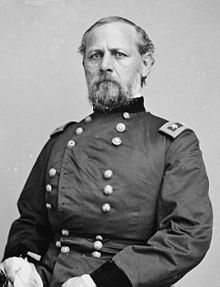
Despite attempts to maintain neutrality, relatives on both sides often fought. Around 100,000 Kentuckians were on the side of the Union , around 40,000 men championed the cause of the Confederation. The strategic potential of the state had recognized the two armies so that different skirmishes and numerous guerrillas - Raids took place in the territory. The Battle of Perryville is considered to be the most violent confrontation, in which 7,600 soldiers died and 5,400 were wounded when Northern General Don Carlos Buell missed an acoustic shadow to confront Braxton Bragg's outnumbered troops .
The civilian population suffered from attacks by the Bushwhackers gangs from the south until the end of the war . Nevertheless, later, during the reconstruction phase (1865–1877), demonstratively sided with the south. Since the 1880s in particular, the Ku Klux Klan pursued a policy of intimidation towards the colored and liberal population.
Agricultural and industrial growth, monopolies
After the decline of the hemp industry , which had previously produced most of the sacks in the States, the cultivation of " Burley tobacco " changed the agricultural landscape decisively. With this high-quality product, new sales markets could be opened up.
When the Kentucky Railway Company opened the Powell County's rail line in 1886, the country's cedar industry expanded at the same time . The Red River Lumber Mills Company, founded six years earlier, was considered the largest steam-powered sawmill in the state. Around 1890 a literal "run" began on America's largest cedar plantation near Clay City. However, the boom in the region came to an unexpected end in 1906 with a devastating large fire from the mills and plantings.
The “ Black Patch Tobacco War ” between 1904 and 1909 expressed the dissatisfaction of small and medium-sized suppliers who ultimately successfully fought against the tobacco monopoly of a few large suppliers.
The greatest upheaval was expressed in the change from an agricultural to an industrial state, which was almost completed during the Second World War . In addition to the textile production, it was above all the coal mining and tobacco processing industry that paved the way for other branches of production. Because of the Great Depression in 1930, many farmers and miners were forced to seek work in the cities. However, it was not until 1970 that more workers were employed in the cities than in the countryside.
In 1936, the US state treasury with its gold reserves was established in Fort Knox .
In the winters of 1936/37 catastrophic floods occurred in many parts of the state, during which thousands had to be evacuated. In Louisville and Mayfield , entire streets were flooded when the Ohio River overflowed.
World Wars and Korean War
As a member of a state proud of its militant border tradition, many Kentuckians fell in Europe during the First World War . With the stationing of the 29th Aero Squadron, an airfield was created for the first time on Godman Field near Fort Knox; the Squadron and the 31st Balloon Corps remained at this location from 1918 to 1921. After this anachronism ended , the base remained orphaned until the 12th reconnaissance squadron was housed in 1937. During the Second World War, the base housed various bomber squadrons , all of which were equipped with the twin-engine Martin B-26 "Marauder" model, which was mainly used in Italy and in the Pacific War .
Robert H. Brooks was the first African American to join the previously exclusively “white” National Guard before the war began. In a Japanese bombardment of the Philippines he was officially the first armed soldier in the American armed forces to be killed on December 8, 1941 after the Japanese declaration of war. In his honor, the parade ground in Fort Knox was renamed "Brooks Field" just two weeks later. This ambivalent signal about the emancipation of colored people in the south was initially limited to the army, in which social advancement was possible but still associated with obstacles.
Another relic of the war can be found in Camp Breckinridge, in Union County near Morganfield, where from 1943 to 1946 a prisoner of war camp for around 3,000 German Wehrmacht soldiers was set up in additional barracks on the site of the original training camp for recruits . As everywhere in the United States, the prisoners of war as cheap labor in agriculture and handicrafts were soon part of economic life in view of the shortage of workers of around 9,000 fallen after initial mistrust, which, given the circumstances, ensured them a good livelihood.
Just five years after the end of the war , soldiers from Kentucky died again in the Korean War , with the posthumously highly decorated field chaplain Herman Felhoelter being declared a "national hero" for both the Catholic Church and the state because of his selfless behavior.
Civil rights movement
In the 1950s, the educational landscape gradually changed. As part of the integration policy of the University of Louisville, parts of the rest of the campus and neighboring institutions were incorporated. As a result, the African-American professor Charles H. Parrish Jr., a renowned sociologist and lifelong advocate of civil rights, came from Louisville Municipal College, where previously only colored people were enrolled , as the first black professor at a “white” college in the south. There he was chair of sociology from 1959 and openly cultivated his relationships with the civil rights movement .
From the reconstruction phase , Kentucky was a Democratic stronghold until the 1990s . They were replaced by the Republicans , who promised a more favorable business climate. Over the course of this decade, the government succeeded in curbing hard coal production , strengthening tourism as an important service sector through the establishment of nature parks, compensating for the loss of jobs and expanding social welfare. In this area in particular, however, Governor Ernie Fletcher withdrew a lot, even cutting the social security of government employees against multiple protests.
politics
The capital of Kentucky is rather small-town Frankfort with fewer than 30,000 residents . As governor held office since December 2019 Andy Beshear of the Democratic Party , of the incumbent since 2015 Matt Bevin from the Republican Party replaced. (see also List of Lieutenant Governors of Kentucky ) In the United States Senate , the state has been represented by Mitch McConnell since 1985 and by Rand Paul (both from the Republican Party ) since 2011 ( List of United States Senators from Kentucky ). The delegation to the 116th Congress House of Representatives consists of five Republicans and John Yarmuth as the only remaining Democrat. ( List of Members of the US House of Representatives from Kentucky ).
The state had long played a special role in party politics in that it had always had a few republican strongholds, but otherwise it had a share in the absolute dominance of the Democrats in the southern states for decades. Like most Southern states became Kentucky with the large displacement of the parties since the 1960s, an increasingly Republican-dominated state, especially in federal elections because the Democrats during the 1960s increasingly liberal and the Republicans increasingly conservative were and the conservative Southern Democrats changed sides over time. In presidential elections between 1960 and 2004 there was a similar development as in Tennessee . Only the two candidates from the southern states, Jimmy Carter in 1976 and Bill Clinton in 1992 and 1996, were able to win Kentucky over for the Democrats. However, Kentucky has always been very "accurate" in the presidential election. The only candidates in the last few decades who won a presidential election without winning in Kentucky were Barack Obama in 2008 and 2012 and John F. Kennedy in 1960.
| year | republican | Democrats |
|---|---|---|
| 1960 | 53.59% 602,607 | 46.41% 521,855 |
| 1964 | 35.65% 372,977 | 64.01% 669,659 |
| 1968 | 43.79% 462,411 | 37.65% 397,541 |
| 1972 | 63.37% 676,446 | 34.77% 371,159 |
| 1976 | 45.57% 531,852 | 52.75% 615,717 |
| 1980 | 49.07% 635,274 | 47.61% 616,417 |
| 1984 | 60.04% 822,782 | 39.37% 539,589 |
| 1988 | 55.52% 734,281 | 43.88% 580,368 |
| 1992 | 41.34% 617,178 | 44.55% 665,104 |
| 1996 | 44.88% 623,283 | 45.84% 636,614 |
| 2000 | 56.50% 872,492 | 41.37% 638,898 |
| 2004 | 59.55% 1,069,439 | 39.69% 712,733 |
| 2008 | 57.37% 1,048,462 | 41.15% 751,985 |
| 2012 | 60.49% 1,087,190 | 37.80% 679,370 |
| 2016 | 62.54% 1,202,942 | 32.69% 628,834 |
The Republicans were also able to continuously improve their election results at the state level. While the Democrats were able to keep the most important state offices such as governor and attorney general for a long time, the Republicans managed to fill almost all of these offices for the first time in the 2015 elections; the nearly 44 percent that the Democratic gubernatorial candidate Jack Conway achieved in November 2015 was the worst result for the party in this office since the Civil War. The traditionally democratic, coal-rich, union-dominated southeast of the country, in which many blame the Obama administration's energy policy for its decline, also voted for the first time in the 2010s by a majority Republican.
In the Electoral College Kentucky provides eight electors . In 1988 there were nine.
The Kentucky General Assembly is a bicameral system with a Senate of 38 members, each representing an electoral district for a four-year term, and a House of 100 members, also representing an electoral district.
The death penalty is available in Kentucky . The last execution in Kentucky took place in 2008. There have been 3 executions in total since 1976. 35 inmates are awaiting execution. (As of January 2016)
Culture and sights
Culture
As in many other predominantly rural regions, cultural life is shaped by the traditions of the American South. Country musicians like Billy Ray Cyrus or Loretta Lynn have shaped music history since the 19th century. A special genre of country music, the bluegrass , created around 1945 by Bill Monroe and Earl Scruggs , among others , has even been named after the state's nickname . But some renowned jazz musicians such as Al Casey and Lionel Hampton also come from Kentucky.
The Kentucky Derby on the first Saturday in May is not only a sporting and economic, but also a cultural event that has always been celebrated with a cultural program during the two weeks of racing, both at the level of high finance and the common man.
During the 20th century, Louisville had a reputation for being the most sophisticated city north of St. Louis . To this day, most of the cultural institutions are concentrated here, such as the J. B. Speed Art Museum, with exhibits from American and European painting and a special Kentucky Collection , the Kentucky Museum of Natural History and the Kentucky Derby Museum with a comprehensive exhibition on horse racing. In 1927 the War Memorial Auditorium was built to commemorate the war dead in the city. Many important writers, artists and musicians such as George Gershwin , Helen Hayes , Arthur Rubinstein , Mikhail Baryshnikov and the Peking Opera performed there. Lexington is also home to an opera venue, the Lexington Opera House .
- Abraham Lincoln Birthplace National Historic Site in Hodgenville
- Visit any whiskey distillery, although no alcoholic beverages may be served in the “dry zone” during factory tours , so only bourbon balls are distributed
- Cumberland Falls , a waterfall that under conservation stands
- Fort Knox as the location of the state reserves
- Kentucky Derby in Louisville
- Mammoth Cave National Park (see picture), the world's largest cave system with a total length of over 300 km
- National Quilt Museum in Paducah
- Red River Gorge Geological Area, a protected canyon system
- JB Speed Art Museum in Louisville
- War Memorial Auditorium
Natural monuments
| National park | location | view |
|---|---|---|
Mammoth Cave National Park
Commons : Mammoth Cave National Park - Pictures
|

|
Economy and Infrastructure
The real gross domestic product per capita real GDP was 44,409 dollars in 2016, while the average of the US states was 57,118. This placed Kentucky 42nd among the 50 states. The unemployment rate was 4.7% in November 2017 (national average: 4.1%).
Agriculture is dominated by horse breeding in many regions , but cattle , dairy products , tobacco , pigs , soybeans , grain and whiskey are more important . Kentucky is the state with the highest exports of livestock and livestock products. Hence, the state is considered the "meat pot" of Chicago and its slaughterhouses , a role that has expanded to the surrounding states. It is the only agricultural branch in the state's economic balance sheet among the ten branches with the highest turnover. The importance of the thoroughbreds and their 381 studs in the collective consciousness can be seen from the fact that in 1947 about 2000 mourners paid their last respects to the racehorse Man o'War in Lexington at its funeral. Another famous gallop, Seabiscuit , was both a literary and a cinematic monument . The background of official homepages is often dominated by horse motifs.
The industry produces automobile parts, chemical products, electrical goods and machines, plus coal mining.
Kentucky whiskey

The most famous product besides horses is the whiskey distilled here . 90 percent of the bourbon whiskey consumed in the world comes from this state. The process of " toasting ", in which the inside of the hickory barrels are exposed to an open flame for around 45 seconds, removes sugar from the wood , which is now contained in the carbon layer. This gives the whiskey its aroma and characteristic color.
The Forman Brown Corporation was founded in 1872 when a certain Mr. Brown started a distillery in Louisville . Two years later, his partner Forman joined them. Over the years, the company grew steadily in order to maintain itself as one of the few licensed producers of medicinal alcohol during the prohibition period . In addition, the company had to focus on the manufacture of "non-specialist" products such as B. fall back on gunpowder . The acquisition of the "Early Times" distillery in 1935 and the well-known Jack Daniel’s label and the expansion of the product range in the 1970s with the acquisition of the Canadian Mist and Southern Comfort brands secured him a dominant market position. Woodford Reserve is Brown-Forman's "super-premium" bourbon and is made in Woodford County.
Other major Kentucky whiskey producers include Wild Turkey , Maker's Mark , Jim Beam , Four Roses , Buffalo Trace, and Heaven Hill .
Alcohol sales laws
While most bourbon whiskey is made in Kentucky, buying alcoholic products is banned in 61 of the state's 120 counties. In some municipalities, alcohol may be sold within the city limits - but not within the jurisdiction of the respective county. In contrast, other municipalities allow liquor to be purchased in the county, but not within the city limits. In twelve counties, however, only the amount of serving or sale is limited, eight administrative districts allow liberalized use on golf courses , and six counties exempt wine from the regulation.
Automotive industry and suppliers
In Bowling Green, around 900 workers at a GM group plant mainly build the Chevrolet Corvette .
On August 4, 2004, the German tire manufacturer Continental confirmed that it intended to suspend tire production at the Mayfield plant for an indefinite period at the end of the year due to restructuring measures, despite the favorable forecasts . In November 2004, the company announced that it was able to further expand its leading market position in the USA for electronic stability control systems ( ESP ). The big manufacturing companies from Detroit announced that they would equip almost all new models with this safety equipment.
The Dr. Schneider Unternehmensgruppe , an automotive supplier from Kronach in Upper Franconia , has been operating a factory for the manufacture of automotive parts in Russell Springs since 2014.
Other companies
The first Kentucky Fried Chicken - Restaurants in 1930 by Colonel Sanders in a gas station in Corbin founded. Today there are over 12,300 fast-food restaurants in this franchise - system catering in over 80 countries worldwide, the company headquarters are in Louisville.
traffic
Public transportation
Public transportation is underdeveloped in Kentucky. No passenger traffic is operated on the state's rail network . On December 18, 1999, 20 years after the last passenger train was shut down , there was an attempt to revive rail passenger transport with the Kentucky Cardinal from Louisville to Chicago. However, this attempt failed on July 6, 2003. The Greyhound Lines buses run to the interstates in the south of the major metropolises , but many towns are neglected by them. The large number of tollbooths on the highways also required small change to be kept ready. A number of “turnpikes” (toll roads), especially in the west of the state, have been paid off for ten to fifteen years and can therefore be used free of charge.
Road traffic
The speed limit on multi-lane interstate highways outside the city limits is 65 miles per hour (= 105 km / h ). In some rural areas, the speed limit was increased to 70 miles an hour in 2007. On the other highways and country roads, especially the nature reserves (“Parkways”), there is generally a speed limit of 55 miles, i.e. 88 kilometers per hour.
Tempo 25 or 35 (40 or 56 km / h) applies within the cities. In Kentucky, as in other states, there is an exception that allows you to turn right and in some exceptional cases even left turns at red lights . Only where the traffic sign “No Turn on Red” can be seen do you have to stop at a red junction.
air traffic
If you want to travel by plane in this state , you usually choose the hub in nearby Illinois, Chicago O'Hare International Airport . The nearest airport that can be reached directly from Germany is Cincinnati-Northern Kentucky International Airport , which is located in Covington (hence the IATA abbreviation "CVG"). However, Cincinnati is north of the river in Ohio.
Sports
In addition to equestrian sports , for which Kentucky is one of the centers of the United States and also hosted the World Equestrian Games in 2010 , the traditional team ball sports are in the foreground: American football , baseball and basketball .
As in many other states that do not have a professional major league sports team, the respective sports teams of the colleges play a very important role, which clearly surpasses that of the second-rate minor league .
This is especially true of the three Division I Football Bowl Subdivision (FBS) programs, including the University of Kentucky Kentucky Wildcats , the Western Kentucky University Hilltoppers, and the University of Louisville's Louisville Cardinals . The Wildcats, Hilltoppers and Cardinals are among the oldest basketball teams in the United States, with nine championships and 22 entries in the round of the top four teams to these teams. The Kentucky Wildcats occupy the top position in the statistics of the USA and are only surpassed by UCLA in the number of NCAA championships .
Kentucky has some minor league teams such as B. in baseball the Lexington Legends (Class A / South Atlantic League) and the Louisville Bats (Class AAA). The state is also home to Florence Freedom from the Frontier League and various teams in the Mid Continental Football League.
State symbols
- Anthem : My Old Kentucky Home by Stephen Collins Foster, 1853
- State tree : tulip tree (magnolia)
- State flower: goldenrod
- State gemstone: freshwater pearls
- State fish: Kentucky perch
- State fossil: brachiopod
- State motto: " United We Stand, Divided We Fall "
- State horse: thoroughbred
- State butterfly: Viceroy Butterfly
- State bird: Red Cardinal
- State wild animal : gray squirrel
literature
History monographs

- R. Barry Lewis (Ed.): Kentucky Archeology , University Press of Kentucky, 1996, 2015.
- Thomas D. Clark: A History of Kentucky. Prentice-Hall, New York 1937; New edition: J. Stuart Foundation, Lexington 1992, ISBN 0-945084-30-7 .
- J. Goldstein: Kentucky Government and Politics. College Town Press, Louisville 1984, ISBN 0-89917-421-3 .
- Lowell H. Harrison, James C. Klotter: A New History of Kentucky. University Press of Kentucky, Lexington 1997, ISBN 0-8131-2008-X .
- Lowell H. Harrison: The Antislavery Movement in Kentucky. University Press of Kentucky, Lexington 1978. ISBN 0-8131-0243-X .
- Larry Gara: The Liberty Line: The Legend of the Underground Railroad. University of Kentucky Press, Lexington 1961, 1996, ISBN 0-8131-0864-0 .
Representations
- Nartha Ellen Zenfell: USA. The old south. Virginia, Kentucky, Tennessee, North, and South Carolina. APA Publications, Munich 1995. ISBN 3-8268-1474-6 .
Web links
- Official website of the state of Kentucky . Retrieved December 18, 2010. (English)
- Kentucky Tourist Office
- Kentucky Historical Society
- Kentucky's educational program
- Specialty Museums in Kentucky
- History of Slavery in Kentucky
Individual evidence
- ^ Online Etymology Dictionary: Kentucky
- ↑ Marquis James: Andrew Jackson - The Border Captain, Indianapolis, Bobbs-Merrill Co. (1st ed. 1933) NA: READ BOOKS: 2007, p. 67f .; ISBN 1-4067-5192-8 ; James Parton: Life of Andrew Jackson, New York: Mason Bros. 1867, p. 529.
- ^ Lakes , in John E. Kleber: The Kentucky Encyclopedia. Associate editors: Thomas D. Clark, Lowell H. Harrison, and James C. Klotter. The University Press of Kentucky, Lexington, Kentucky 1992, ISBN 0-8131-1772-0 .
- ↑ Kentucky Department of Fish and Wildlife Resources: Elk Restoration Update and Hunting Information ( Memento of September 26, 2006 in the Internet Archive )
- ↑ Hunters counted 29,006 hunted birds during the 23-day hunting season in Spring 2009, according to: Kentucky Department of Fish & Wildlife Resources: Hunters Take Record Number of Spring Turkeys ( Memento from June 23, 2012 in the Internet Archive )
- ↑ Kentucky Geography from NETSTATE. In: netstate.com. Retrieved February 28, 2015 .
- ↑ Bryan S. Bush: The Great Cyclone of 1890: Tragedy Struck Louisville ( Memento of September 21, 2015 in the Internet Archive )
- ↑ "Super Tuesday Tornado Outbreak". National Weather Service ( Memento of March 28, 2008 in the Internet Archive )
- ↑ "National Death Toll Hits 55 in Ice Storm, 24 in KY". ABC News. 2009 ( Memento from July 18, 2011 in the Internet Archive )
- ↑ Acer saccharum, A. rubrum, Aescualus octandra, Fraxinus americana, Tilia heterophylla, Liriodendron tulipifera (Magnoliaceae), Fagus grandifolia, Castanea dentata, Quercus rubra, Q. prinus, Q. alba, Magnolia acuminata, Nyssa sylvatica. (Nyssa sylvatica) nigra u. J. cinera
- ↑ Liriodendron, Fraxinus and Tilia
- ↑ Burga / Klötzli / Grabherr (ed.): Mountains of the earth. Landscape, climate, flora, Ulmer: Stuttgart 2004, p. 205.
- ^ US Census Bureau _ Census of Population and Housing . Retrieved February 28, 2011
- ↑ Extract from Census.gov . Retrieved February 28, 2011
- ↑ Extract from census.gov (2000 + 2010) ( Memento from June 22, 2015 in the Internet Archive ) Retrieved on April 2, 2012
- ↑ US Census Bureau
- ↑ Kentucky - Age and Sex
- ↑ Sciencedaily: Gap growing between longest and shortest lifespans in the US , May 8, 2017
- ^ Kentucky - Selected Social Characteristics
- ↑ The date is not exactly documented, in the historical accounts one can only agree on the approximate time
- ^ The Filson Club History Quarterly, Louisville 2000, p. 169; The Ohio Journal of Science, Columbus, Ohio: The Ohio State University and the Ohio Academy of Science 1915, p. 71.
- ^ Susan Yarnell: Southern Appalachians: History of the Landscape , DIANE Publishing 1999, p. 4, ISBN 0-7881-4116-3
- ↑ Holmes, William FS: Hardin Village: A Northern Kentucky Late Fort Ancient Site's Mortuary Patterns and Social Organization , Department of Anthropology, University of Kentucky, Lexington 1994
- ↑ The Wyandot are a sub-tribe of the Iroquois League
- ↑ Kenneth P. Bailey: Christopher Gist: Colonial Frontiersman, Explorer, and Indian Agent , Archon Books: 1976, ISBN 0-208-01564-7 .
- ↑ Thomas Dionysius Clark: Kentucky, Land of Contrast, New York: Harper & Row 1968, pp. 7ff.
- ↑ Logan Esarey, William F. Cronin: History of Indiana from Its Exploration to 1922 , Dayton, Ohio: Dayton Historical Publishing Co. 1918, p. 89; Lowell Hayes Harrison, James C. Klotter et al. a .: A New History of Kentucky, Lexington: University Press of Kentucky 1997, ISBN 0-8131-2008-X , p. 41
- ↑ See James M. McPherson: Die for Freedom. The history of the American Civil War. 7th edition. List, Munich / Leipzig 1997, pp. 280–284.
- ↑ Bret Harte, Anton Roman (Ed.): Overland Monthly and Out West Magazine. A. Roman & Company, San Francisco 1935, p. 19.
- ^ McPherson, Die For Freedom, pp. 512f; History of the Battle of Perryville
- ^ Henry George: History of the 3d, 7th, 8th, and 12th Kentucky CSA Simmons Historical Publications, Lyndon, Kentucky 1987, p. 81.
- ↑ Annual Report. Kentucky Mines and Minerals Dept. no. 5, 1887
- ^ Dianne Wells, Thomas H. Appleton, Melba Porter Hay: Roadside History: A Guide to Kentucky Highway Markers. University Press of Kentucky 2002, p. 316, ISBN 0-916968-29-4 .
- ↑ Donald Keyhole: The Flying Saucers Are Real, 1st World Publishing 2004, ISBN 1-59540-622-0 , p. 60
- ^ Dianne Wells, Thomas H. Appleton, Melba Porter Hay: Roadside History: A Guide to Kentucky Highway Markers. University Press of Kentucky 2002, p. 262.
- ↑ see for example Guido Knopp's documentation "The Prisoners"
- ^ Dwayne D. Cox: The University of Louisville , University Press of Kentucky 1999, p. 100
- ^ Joel Turner, Scott Lasley: Political Parties and Elections in Kentucky. In: James C. Clinger, Michael W. Hail (Eds.): Kentucky Government, Politics, and Public Policy. University Press of Kentucky, Lexington 2013, ISBN 978-0-8131-4315-6 , pp. 163-183, here p. 163.
- ^ David Leip: Dave Leip's Atlas of US Presidential Elections. Retrieved December 2, 2018 .
- ↑ James Hohmann: Matt Bevin Tries On Outsider Message in Kentucky Governor's Race. In: The Washington Post , November 2, 2015; Kentucky - Summary Vote Results. In: Associated Press , November 4, 2015. See generally David Weigel: Off-year Elections Reveal a 2016 Map With Sharper Borders. In: The Washington Post , November 4, 2015.
- ^ Eric Ostermeier, Kentucky Democrats Turn in Worst Showing in Gubernatorial Race Since the Civil War. In: Smart Politics , November 4, 2015 (English). See also Rae Hodge: Meet the Republican Mitch McConnell Called a “Pathological Liar”: How Gov.-elect Matt Bevin Decimated Kentucky Democrats. In: Salon.com , November 4, 2015 (English).
- ↑ See Manuel Quiñones: Coal: Democrats, Like Mining, May Never Fully Recover in Appalachia for 2014 . In: EENews.net , October 17, 2014 (English); Manu Raju, Lucy McCalmont: Mitch McConnell Defeats Alison Lundergan Grimes in Kentucky. In: Politico .com , November 4, 2014, updated November 5, 2014 (English).
- ↑ www.270towin.com
- ↑ Kentucky Legislature. Senate Members
- ^ Project Vote Smart - State House of Kentucky ( Memento from August 20, 2011 in the Internet Archive )
- ^ US Department of Commerce, BEA, Bureau of Economic Analysis: Bureau of Economic Analysis. Retrieved August 27, 2017 (American English).
- ^ Unemployment Rates for States. Retrieved January 8, 2018 .
- ↑ http://www.corvetteassembly.com/Facilities/public/us/en/bowling_green/about_us.html
- ↑ Dr. Schneider - Group: Russell Springs, USA: dr-schneider.com. Archived from the original on August 31, 2017 ; accessed on August 31, 2017 (English).
- ^ Governor Ernie Fletcher's Communications Office. In: migration.kentucky.gov. March 21, 2007, accessed February 28, 2015 .
Coordinates: 37 ° 50 ′ N , 84 ° 16 ′ W





